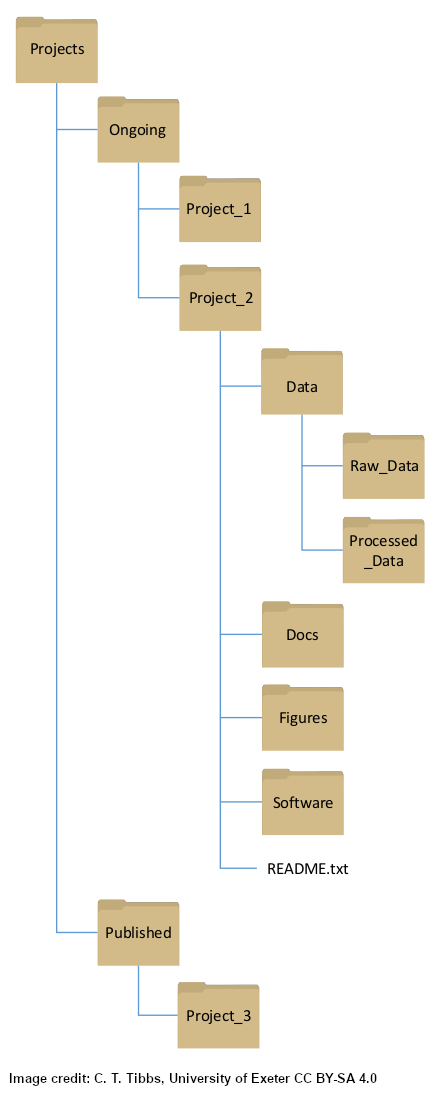
Organising your data
Directory structure and file names
Using a logical file structure with meaningful file names will save you time by making it easier to locate and keep track of your files. Use folders to group research into different topics and use a hierarchical structure, with a few folders covering broader topics, with subsequence folders within these.
A file name should provide context about the content of the file such as:
- Date eg, 2018_03_17
- Content description eg, DAF_Survey_Procedures
- Version number eg, _v1.1
- Creator name eg, _HLJ
A good file name should allow you to determine the contents of the file without having to open it.
Tips for naming your files and folders:
- When using dates, put them in YYYYMMDD or YYYY_MM_DD format at the beginning of the file name to enable files to be sorted chronologically eg, 2018_07_01_Interview_HLJ
- Use underscores rather than blank spaces between words eg, Website_text.
- Don't use special characters in filenames: & , * % # ; * ( ) ! @$ ^ ~ ' { } [ ] ? < >
- Keep the file name as brief as possible.
- Define a standard vocabulary and only use meaningful abbreviations.
- Order the elements of the file or folder name from general to specific.
- Keep the file name independent of its location. It is better to name your file 2018_07_01_Interview than Interview even if the file is saved in a folder called 2018_07_01. This means that if you search for Interview and many files are found, you know which file is the relevant one.
Version control
Use a unique file name with a date or version number eg, 2018_03_17_Image3 or Image3_v1.2. You can also use a version control table or file history alongside the data file to provide more details of changes to the file:
| File name | Changes to file |
|---|---|
| Image3_v1.0 | Original image |
| Image3_v1.1 | Minor revisions made |
| Image3_v1.2 | Further minor revisions |
| Image3_v2.0 | Substantive changes |
If multiple people are collaboratively working on the same files, decide on a strategy at the beginning that everyone understands. You could use software to control the permissions to each file eg, decide who has read-only permissions and who has write permissions, or alternatively you could also use version control software such as Git, SVN, or CVS.
Documentation and metadata
What additionally information is required to make your data understandable and usable? Data without this contextual information are essentially meaningless. Therefore, it is extremely important that data are continuously documented. Supporting documentation and metadata should combine with your research data to make it understandable independently of any other publication. Metadata is commonly described as data about data and includes information such as:
- Who created the data?
- Who published the data?
- An abstract of the data.
- A description of the data.
- Key dates associated with the data.
- Who funded the research?
- Rights information.
Supporting documentation should include:
- A brief description of the project
- A description of the methodologies, protocols, sampling techniques that were used to produce the data
- A discussion of any assumptions that were made in the data collection/creation/analysis
- An explanation of the content of all of the data files and how they relate to each other
- A detailed list of all of the variables and what they represent
- A list of any software that is required to access/analyse the data
- Any anomalies in the data
Electronic Notebooks
Electronic Notebooks are designed to support reproducibility and collaboration in research, by helping you organise, work with, and share your research notes. Electronic notebooks are analogous to paper notebooks, but there are many benefits to managing your notes electronically, including the ability to remotely access your notes, increased searchability within and across notebooks, more straightforward to share your notes with collaborators, easier to back up, and more control over different versions.
University researchers have institutional access to two electronic notebooks: Microsoft OneNote and LabArchives.
- OneNote is part of the Office365 suite of applications and more information on how to access and use OneNote can be found in this Digital Hub espresso session.
- LabArchives is a dedicated electronic lab notebook and these Digital Hub guides can help you sign in and get started.
